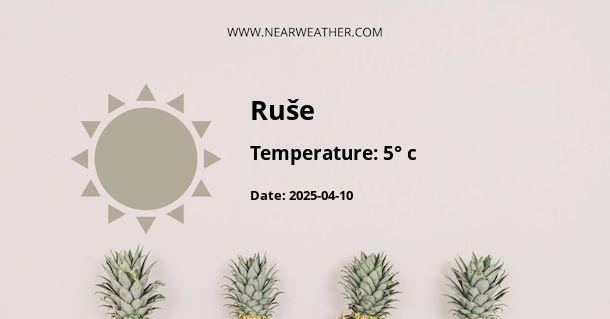Understanding the Climatic Patterns of Ruse, Slovenia
The picturesque city of Ruse, situated in Slovenia, experiences diverse weather conditions throughout the year. Its climate is classified as a temperate continental climate, which typically entails warm summers and cold winters, with a fair amount of precipitation spread across all months. To give readers an in-depth view of Ruse’s climatic nuances, let us delve into the seasonal variations, climatic statistics, and local weather phenomena that define this charming European locale.
Seasonal Climate Overview
Winter (December to February)
Winters in Ruse can be brisk and snowy, with temperatures frequently dropping below freezing. December witnesses the onset of the coldest season, with temperatures often falling between -5°C to 5°C. January and February are considered the coldest months, with average lows dipping to approximately -6°C.
Skiing and other winter sports are popular in this season, leveraging the region’s cold yet hospitable conditions."Winter in Ruse brings about a snow-covered landscape that is both a challenge for the inhabitants and a boon for winter sports enthusiasts.", say local meteorologists.
Spring (March to May)
Spring breathes new life into Ruse as the snow melts and temperatures gently rise. March still carries a chill, with average temperatures hovering around 8°C, but by the time May arrives, the climate becomes much more temperate, with averages of 20°C. This season experiences a mix of sunny days and rain showers that contribute to the budding flora around the city.
Summer (June to August)
Summer in Ruse is characterized by warm, pleasant days and mildly cool evenings. Temperatures in June start at an average of 25°C, escalating to around 30°C in the peak of July. Summers are also the wettest season, with occasional thunderstorms.
According to climatology experts, "The confluence of warm and cold fronts in this region can lead to dramatic thunderstorms, especially in high summer, making it a visually spectacular yet potentially disruptive season."
Autumn (September to November)
Autumn sees a gradual cooling from the warmth of summer. September maintains a warm touch with averages around 22°C, but by November, the temperature has fallen to an average of 10°C. This is the time when Ruse displays a stunning change in foliage, making it a popular time for photography and outdoor activities.
Monthly Climate Details
To facilitate more precise planning for visitors and locals alike, providing a monthly breakdown with key climatic details is essential. Here is a summarized table showcasing average high and low temperatures, alongside precipitation levels.
| Month | Average High (°C) | Average Low (°C) | Precipitation (mm) |
|---|---|---|---|
| January | 4 | -6 | 30 |
| February | 7 | -3 | 28 |
| March | 12 | 1 | 40 |
| April | 18 | 6 | 55 |
| May | 23 | 11 | 70 |
| June | 26 | 15 | 90 |
| July | 28 | 16 | 95 |
| August | 28 | 16 | 85 |
| September | 23 | 12 | 75 |
| October | 18 | 7 | 65 |
| November | 10 | 2 | 55 |
| December | 5 | -4 | 40 |
Weather Phenomena and Notable Events
Ruse, like many other regions, can experience unique weather events. For example, the Föhn wind, a dry and warm down-slope wind, occasionally affects the area, causing rapid temperature rises and influencing local weather patterns.
"The Föhn effect is known for its ability to cross mountains and descend into valleys, bringing unexpected warmth to Ruse even in the colder months," observe climatologists.
Climatic Impacts on Local Culture and Economy
The climate in Ruse shapes much of the local culture and economy. The fertile land benefits from the evenly spread precipitation, contributing to the region's renowned wine production. Vineyards thrive here, with seasonal weather variations playing a critical role in the quality of the grape harvest.
Moreover, the seasonal weather patterns foster a vibrant tourist industry, with activities ranging from skiing and snowboarding in the winter to hiking and cycling in the milder seasons. Local festivals and events are also often planned in accordance with the favorable weather conditions, with summer and autumn being particularly active periods for cultural festivities.
Climatic Challenges and Sustainability Efforts
Despite Ruse's generally agreeable climate, the city is not immune to the challenges posed by climate change. Extreme weather events, like intense storms and varying precipitation patterns, have made it imperative for local authorities and inhabitants to engage in sustainable practices.
- Efforts to improve energy efficiency in homes and businesses.
- Enhanced management of water resources.
- Development of green spaces to manage urban heat island effects.
- Investments in renewable energy sources and infrastructure.
Adapting to these climatic challenges is a community-wide effort, involving both policy change and individual action. By doing so, Ruse aims not only to protect its environment and residents but also to ensure that the city's natural beauty and resources can be enjoyed by future generations.
Conclusion
Understanding the complex weather patterns of Ruse, Slovenia, requires a comprehensive look at its year-round climate conditions. While temperate weather generally prevails, the city is subject to the typical fluctuations of a continental climate, with seasonal variations that invoke both delight and preparedness in its inhabitants and visitors. As Ruse continues to adapt and respond to climatic challenges, it serves as a dynamic example of how local culture, economy, and sustainability initiatives are intricately linked with the rhythms of nature.
A - Ruše's Latitude is 46.539440 & Longitude is 15.515830.
A - Weather in Ruše is -1° today.
A - Climate Conditions in Ruše shows fog today.
A - Humidity in Ruše is 100% today.
A - Wind speed in Ruše is 1.84 km/h. today.
